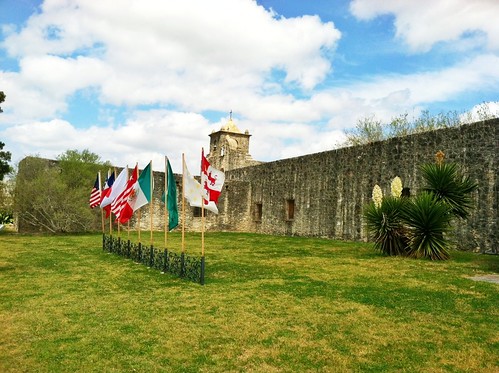Dance music incongruously blares from the historic courtyard where a DJ is testing his sound system for a wedding scheduled later in the afternoon. It is a jarring disruption, and strikes us as a singularly curious choice for nuptials, here where almost 177 years ago -- on Palm Sunday, March 27, 1836 -- 342 soldiers lost their life. “Here” is the Presidio La Bahia at Goliad, Texas where once again we have made pilgrimage. I suppose one could argue that our presence is as odd as the bride and groom’s. We have, after all, been here before. Many times. And as I mentioned, it isn't a happy place.
La Bahia is not the site of a battle. The soldiers did not die in combat. They were prisoners of war slaughtered, in a dramatic presumption of ends justifying means, by their captors. Having surrendered a week earlier, at the Battle of Coleto Creek, under the written assurance of favorable treatment, Colonel James Fannin and his fellow independence fighters were marched back to the fort they had previously occupied as defenders. A week later, under orders from the Mexican President Santa Ana, they were marched back outside, circled and fired upon at close range. A couple dozen managed to survive and escape. A similar number were spared for practical reasons. The bodies of the massacred were simply abandoned where they fell. 342.
It isn't a moment in the popular lore of Texas history that has sustained the high profile mystique of the Alamo -- John Wayne never made a movie about Goliad, nor anybody else in Hollywood for that matter. It was, nevertheless, a galvanizing episode in the Texans fight for independence that was eventually won, a few short weeks later, at the Battle of San Jacinto. But if I have ever been to San Jacinto I don't remember it; and though I have visited the Alamo a few times it feels compelled by a sense of obligation; a historical duty of birthright.
I haven't quite fathomed these pilgrimages to Goliad. Perhaps it is mere proximity or the quietude’s lack of other things to do. Perhaps it is the nostalgic lure of my family’s roots in this area just 15 miles away, making it “ours” in a way only abstractly and collectively true of the Alamo some 90 miles away.
I can't help but sense, however, that the story itself is the hook and line that draw me back again and again -- fathoming the cold calculations of the brutal orders; imagining, or perhaps hoping for, the ambivalence of those carrying them out; channeling the apprehension of those prisoners first rousted and then rustled outside; smelling, even after all these years, the gunpowder and the blood; both hearing and feeling the wing-beats of buzzards descending in subsequent days; and grieving, yet again, the capacity of humankind to treat our fellows as nothing.
I don't know why a couple would choose to get married there -- there among such memories and echoes. But I rather appreciate the symbol of it. In the same way as a dog marks its territory -- overriding the scent of a previous presence -- perhaps a wedding’s declaration of love and hopeful creation is the perfect mark to spray on a site whose prior scent was a noxious and nauseous cocktail of arrogance, ambition, and brutal disregard for the sacredness of life.
I hope the happy couple lives happily ever after. And has lots and lots of kids. 342.
Sunday, March 17, 2013
La Bahia Goliad
Subscribe to:
Post Comments (Atom)

3 comments:
Enjoyed this...who is tending YOUR sprouts?!?!
Tim -- I grew up in Texas and knew the phrase, "Remember Goliad", but not until today, did I understand what that meant. Great writing, great remembering, great sharing. Thanks for a good word. Cathy CJ
We children of Texas are touched by our state's history in such deep ways, aren't we? I share a lifetime of pilgrimages to the Alamo, but, like Cathy, only in adulthood did I learn about and visit Goliad.
In light of your as yet unwritten words about vulnerability, perhaps this unbalanced awareness has developed because at the Alamo a battle was fought and, never mind the number of dead, it was war after all. Both sides died. Vulnerabilities were chosen; vulnerabilities clashed. Thus, death in defeat is heroic, but death via mass assassination is shameful and unmentionable. It speaks of helpless, inescapable vulnerability. And senseless, cruel, unwarranted death.
Is the difference so great?
Long ago, I wrote some teaching/learning materials about I Corinthians for children. I began with ideas and activities about letters and included a look at Travis's letter from the Alamo - a cherished jewel of my Texas childhood. Reading my work, Dick Hoehn not only reminded me that one of the issues the heroic Texans were fighting for was the right to own slaves. He also gently hinted something about glorifying war.
I became immediately aware that he did not grow up in Texas. And that, wise and wonderful as I had become, my roots were showing.
Post a Comment